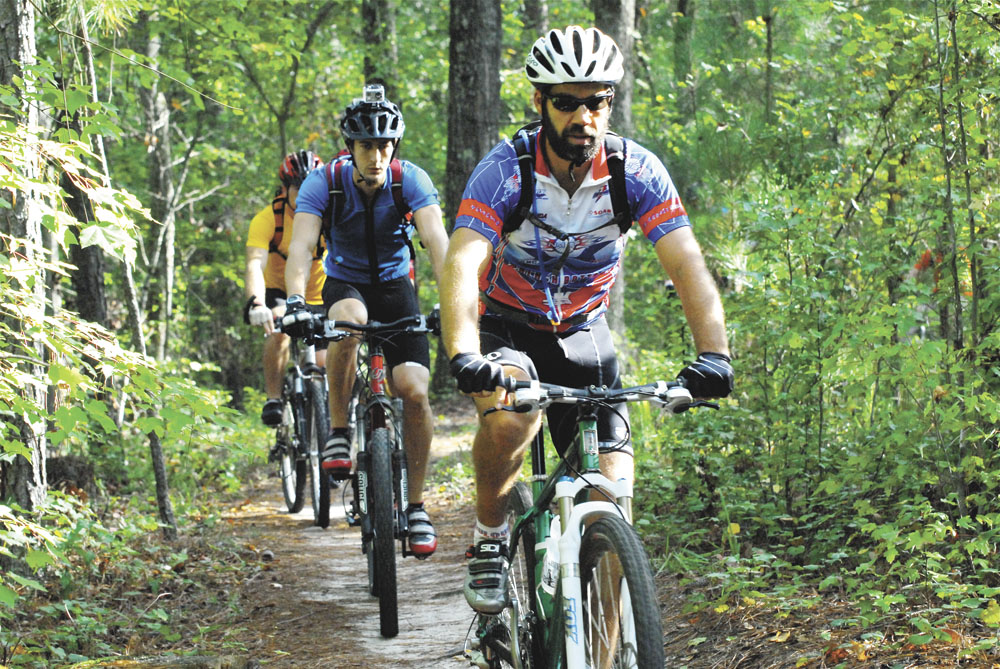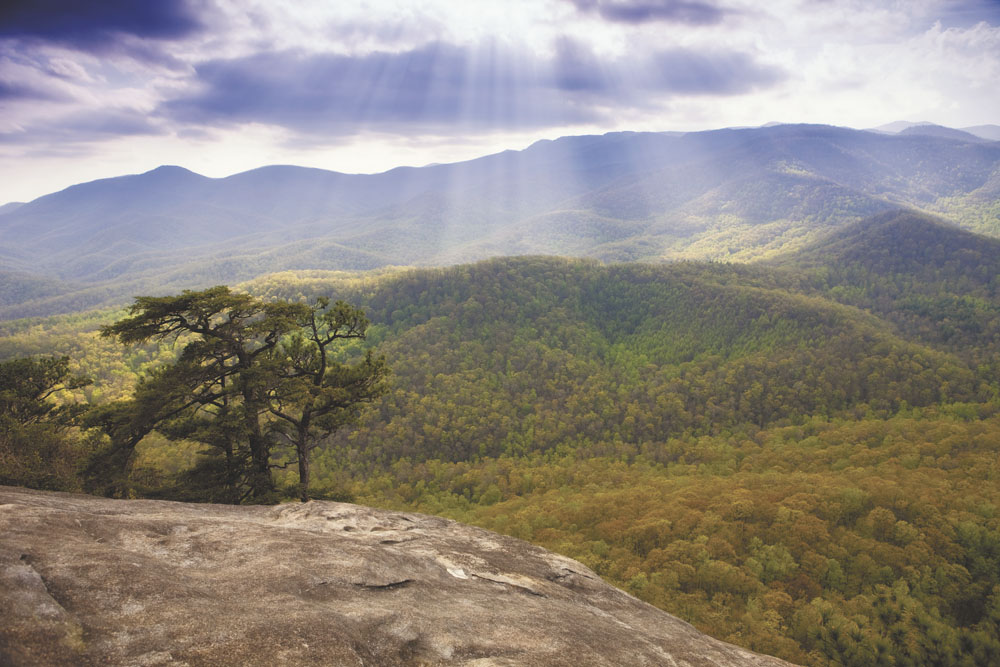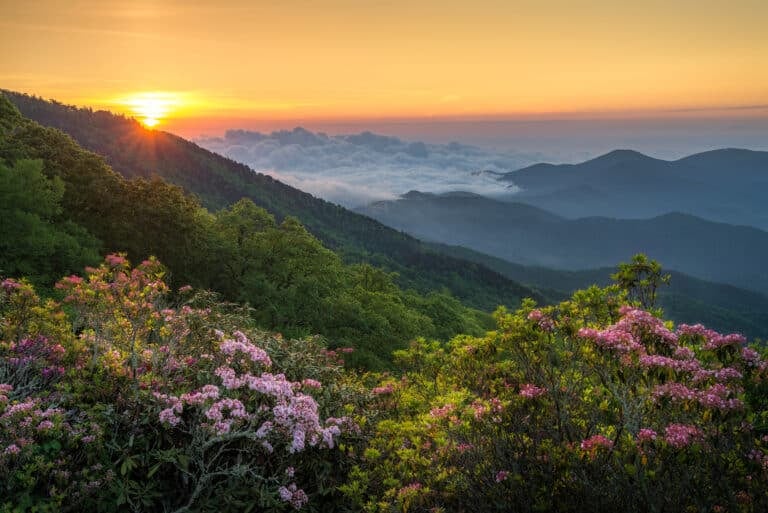Our national parks get all the love. You’ve seen the “Save Our Parks” bumper stickers, maybe you’ve even watched the new Ken Burns documentary The National Parks: America’s Best Idea. Certainly, you’ve heard the public outcry over the park service’s $9 billion maintenance backlog. We get it: our national parks are awesome. Let’s fix ‘em and keep enjoying ‘em.
We couldn’t agree more, but where’s the love for our national forests? Why isn’t there a public outcry over the $10 billion maintenance backlog for our national forest system?
While the most recent stimulus package included billions for the Park Service, most of the small pittance of stimulus money allocated to the U.S. Forest Service is earmarked for logging projects.
Therein lies the rub. While our national parks are celebrated for their beauty and recreation opportunities, our national forests have traditionally been managed for timber. The timber sales operate at a net loss, costing American taxpayers over $1 billion each year. However, recreation is booming in national forests. Five times more outdoor enthusiasts recreate in national forests than in national parks in the Southeast.
When will forest dollars go to trail enhancements instead of logging road enhancements? When will the Forest Service start managing our land for recreation over timber harvesting? There’s one thing you can do to ensure our national forests are treated with as much respect as our national parks in the future: keep exploring them—especially the five hidden treasures we’ve uncovered here. By dispersing recreation across the far reaches of our mountains, we show the U.S. Forest Service that we value all of our forests for more than just timber.
Spread the love. Go forth and recreate.
 WILDEST TRAIL IN THE EAST
WILDEST TRAIL IN THE EAST
[1] Bonas Defeat Gorge
Nantahala National Forest
“The gorge is hard to find and once you get there, there’s no trail. And the flash floods are deadly,” says Bob Kornegay about the Bonas Defeat Gorge, a narrow rock chasm tucked inside a forgotten corner of the Nantahala National Forest. “But it’s a world-class day hike. I say it’s the wildest trail in the East. I haven’t been on every trail, but I can’t imagine anything more adventurous than this.”
Kornegay is a wilderness guide who makes a living by exploring and mapping uncharted tracts of Southeastern forest. If you’ve ever hiked or biked the now-popular Panthertown Valley in the Nantahala National Forest, then you probably used Kornegay’s map—it’s the only one in existence for the recreation area. The fact that there are still large swaths of public land that aren’t dissected by trails and detailed by official maps might come as a shock to you, but it’s no surprise to Kornegay.
“Some people think there’s nothing left to discover in the Southern Appalachians, but our forests are mysterious. They’re complicated and hidden,” Kornegay says. “Look at one of our mountains from a distance, and you wouldn’t think it would be hard to hike it. But actually start hiking, and it gets complicated. You find rock walls, you find creeks, you find gorges.”
It doesn’t get more complicated than the Bonas Defeat Gorge. The two-mile gorge is part of the Tuckasegee River that was dewatered in the ‘50s by the construction of a Duke Power dam. You can find the gorge on the National Geographic topo map of the Nantahala National Forest, but the trail shown on the map doesn’t actually exist. Since there’s no official trail, reaching the mouth of the gorge takes a solid three miles of bushwhacking. Once you’re inside, the real fun starts. You hike right through the center of the gorge, which narrows to 100 feet in certain places. On either side of you, gorge walls rise for hundreds of feet. Sometimes the walls are sheer rock, sometimes they’re steep slopes covered in trees. Massive boulders must be scrambled over, 10-foot deep potholes must be avoided, pools of black tannic water must be waded. There’s some light caving, some low grade climbing, and a real possibility of flash floods. The dam above the gorge releases water if the lake is too full and several creeks feed Bonas Defeat, making flash floods common and deadly. (As a rule, never hike the gorge if it’s rained recently, or if there is even a slight chance of rain in the forecast.)
Including the bushwhack, the total hike is only 5 miles long, but it takes an avid hiker several hours to complete because the terrain is so technical. What’s the reward for all this work? The opportunity to scramble over massive boulders, peer into ink-well dark potholes, slide over smooth rock, and wade through pure tannic water. Oh, and the bragging rights associated with exploring a rocky gorge that only a handful of people have ever set foot inside.
Explore This: The Bonas Defeat Wall is a 300-foot granite cliff lining the gorge that only a few rock climbers have dared to send. Grandma’s Kitchen is a series of cascades dropping through perfectly cylindrical potholes, as if a giant machine has carved them and then sanded them smooth. The Shut In is a corner of the gorge famous for trapping unsuspecting hikers. It’s easy to scramble into this pocket of rock and water, but it’s not so easy to get out.
Spend a couple of days in the area and check out the bike trails at adjacent Panthertown Valley as well as the untapped hiking potential of “The Big Pisgah Tract,” a 4,000-acre chunk of forest just east of Bonas Defeat that houses the headwaters of the West Fork of the French Broad. The impressive Dismal Falls sits inside this forest and there’s also an unnamed trail that follows the headwaters of the West Fork and gets very little attention from hikers. Kornegay has temporarily named that trail the “West Fork Way,” and is in the process of publishing a comprehensive map of the entire area (Bonas Defeat, Panthertown, Big Pisgah Tract) which will include updated trail information.
“My goal is to map the entire area and see use get spread out and have the whole thing become managed for recreation,” Kornegay says. “Panthertown gets a lot of use now, and there are some negative impacts like trail erosion and more campsites. But those pale in comparison to logging roads and clear-cutting.”
The safest way to explore Bonas Defeat is with a guide. Check out Kornegay’s site for more information: slickrockexpeditions.com
 YOUR NATIONAL PARK ALTERNATIVE
YOUR NATIONAL PARK ALTERNATIVE
[2] Great North Mountain
George Washington National Forest
Great views? Check. Dramatic rock outcroppings? Check. Comprehensive trail system with variety of hiking and backpacking options? Check. Killer backcountry camping? Check. Clear mountain streams? Check. Virginia’s Great North Mountain has everything you could want from a national park, except for maybe the paved highway replete with overlooks and crowds of RVs. The Great North Mountain is a 50-mile long ridge that separates Virginia from West Virginia while also defining the western border of the Shenandoah Valley.
A well maintained trail system offers over 80 miles of hiking and biking, along with backcountry campsites with sunrise views of the valley below, trail shelters, even a PATC cabin available to rent. A piece of the Tuscarora Trail even cuts across the mountain. It all sits a mere 95 miles from Washington D.C., and yet, few people bother to explore the vast solitude that is the Great North Mountain. Why? Because Shenandoah National Park sits on the eastern side of the Shenandoah Valley, about a half an hour closer to the Beltway.
“It’s often overlooked as a destination,” says Lee Manning, co-leader of the Stonewall Brigade, the crew responsible for keeping the Great North’s trails in top shape. “D.C. hikers go straight to the Shenandoah and don’t bother driving the extra few miles it takes to get to this ridge. And the visitors who do hike the Great North usually swarm Big Schloss. Most of the other trails are left alone.”
Big Schloss is a massive sandstone outcropping that sticks 50 feet above the tree line, offering views of the Trout Run Valley in West Virginia and Little Schloss in Virginia. The rock wall looks as if it’s made of stacked stone. The approach is short and easy and the views are commanding. It’s a combination that attracts the lion’s share of hikers who venture into the area, but put in some extra miles and you can find equally impressive views and a world of solitude.
Hike This: If you want Big Schloss views without Big Schloss crowds, head to the summit of Tibbett Knob. The 2.4-mile Tibbett Knob Trail leaves from the same trailhead as the hike to Big Schloss (Wolf Gap Recreation Area) but two steep rock scrambles keep the majority of hikers at bay. From the top, you’ll get views of Trout Run Valley that rival those seen from Big Schloss.
For one of the best campsites in the forest, tackle the difficult stream crossings of Bucktail Trail and the steep, rocky climb of German Wilson Trail to the Halfmoon Lookout where the ruins of an old fire tower (and small campsite) reveal massive views of the Trout Run Valley and Big Schloss.
Avoid the crowds with a 9.5-mile loop that combines the Great North Mountain Trail with the Stack Rock Trail and Laurel Run Trail. From the Great North Mountain Trail, you’ll get tremendous cliff top views of the Shenandoah Valley to the east. The ridge top walk is fairly level, but prepare for some steep elevation changes as you climb up Stack Rock Trail and drop down Laurel Run Trail.
Not interested in backpacking? Look into renting the Sugar Knob Cabin, a small stone building (complete with fire place and nearby spring) at the junction of the Big Blue and Stony Creek Trails maintained by the Potomac Appalachian Trail Club: patc.org.
YOUR NEXT EPIC RIDE
[3] Allegheny Highlands Trail System
George Washington and Jefferson National Forest
We owe a debt of gratitude to the Civilian Conservation Corps, the New Deal organization responsible for building the majority of the Southeast’s hiking trails and recreation areas. The CCC spent countless hours in the ‘30s and ‘40s cutting trail through the Southern Appalachians, providing a recreational legacy for future generations, but it couldn’t predict the wants and whims of those future recreationists.
“They just didn’t think about loop trails back then,” says Sharon Mohney, the recreation manager for the James River District of the George Washington and Jefferson National Forest. Mohney’s district is full of classic CCC point to point hiking trails, but her users were asking for something a little more…modern. “Equestrians, mountain bikers, they want loop trails, so that’s what we’re building.”
Mohney is referring to the Allegheny Highlands Trail System (AHTS), a remarkable forest service project that is connecting existing hiking trails between the town of Covington and Douthat State Park to create 63 miles of loops. The plan calls for 14 miles of newly constructed trail, 9 miles of which are already on the ground thanks to the sweat equity from Virginia’s IMBA members and an industrious group of Boy Scouts known as the Order of the Arrow Core. While equestrian groups were the driving force behind the new trail system, mountain bikers recognize the backcountry riding potential these extensive loops promise and have been more than eager to pitch in. The Allegheny Highlands Trail System centers around Douthat State Park, which is already a much-loved fat tire destination. The addition of the Allegheny Highlands Trail System gives bikers more than 100 miles of connected singletrack and forest roads to ride near Covington.
“The Forest Service thought outside of the box on this one,” says Chris Scott, Virginia’s IMBA rep and owner of Shenandoah Mountain Touring. “There are some neat, innovative connectors in this system that create all these loop opportunities that let you get deep into the forest for an ‘out of the park’ experience.”
Some of the key connectors are already on the ground and Mohney plans to have the entire system completed within the next two years. Scott’s Shenandoah Mountain Touring guides clients on multi-day off-road rides in the Harrisonburg area, but is already designing guided trips within the Allegheny Highlands Trail System.
Ride This: Fore Mountain Trail is the heart of the Allegheny Highlands. It’s an epic out-and-back ride. When the system is complete, this trail will help comprise a 19-mile loop named after the Boy Scouts’ Arrow Core. Right now, it’s a 14.8 mile trail that connects Covington with Douthat. The terrain oscillates between singletrack and forest road with switchback climbing, ridgeline riding, and decent backcountry camping. Check out the new Douthat Connector for purpose built singletrack that joins Fore Mountain with singletrack inside Douthat State Park.
There are no maps of the new trails yet and no signage has been erected inside the forest, but Mohney says bikers can sample some of the new trails in their early phase. The Peter’s Ridge Trail, which is close to being completed, leaves from the Dolly Ann Work Center and climbs and falls along the mountain of the same name through a series of switchbacks and contoured singletrack.
THE FORGOTTEN PEAKS
[4] Mackey Mountain
Pisgah National Forest
There was a time when the entire country celebrated the peaks and rivers that surround Mackey Mountain in Western North Carolina. After all, this was the first piece of land ever to be designated as national forest in the entire eastern United States, purchased under the Weeks Act of 1911. For decades, Mackey Mountain served as the nucleus of our national forest system in the Southern Appalachians, but today the 5,000-acre roadless area goes virtually unhiked. A few anglers fish the lower reaches of Curtis Creek, and the occasional hiker will explore the trails traversing Mackey Mountain and Buckeye Knob, but the area is mostly left alone, mostly because of its location. Mackey, which tops out at 3,990 feet, sits at the foot of the Black Mountain Range–home to several 6,000 footers including Mount Mitchell. All those taller peaks have stolen Mackey’s thunder over the years, and a once vibrant trail system is now slowly being swallowed by the forest.
“There used to be a network of trails, but most of them are nonexistent now,” says Matt Kirk, an ultra runner living in nearby Marion. “That area is rugged, but pretty. I wouldn’t really call it hiking. Mostly, you’re bushwhacking or crawling through rhododendron looking for those faint trails.”
But to the bushwhacker goes the spoils. The Mackey Mountain Roadless Area may not be in the hiking guidebooks, but it does offer guidebook-worthy hikes. The area is a bear preserve (no hunting) with roughly 5,000 acres of old growth, some of which is considered virgin. As a result, the Sierra Club has listed the area as one of their priorities for possible Wilderness protection. For the hiker, steep mountains rise from clear trout streams.
Unnamed trails exist along Mackey Creek and Laurel Fork, while the remnants of official trails can still be found by adventurous hikers on the higher peaks. Along these trails are hidden waterfalls, ridgetop hikes with big views, steep climbs, blueberries, and the opportunity to catch a glimpse of black bear. All of this sits just outside downtown Old Fort, only 10 minutes from I-40.
Hike This: Hickory Branch Trail is the only trail in the area that receives regular use. It starts at the campground and rolls through rocks and rhododendrons to Hickory Branch Falls, a skinny waterfall with a decent pool at its base. Continue past the falls and you’ll climb steeply to Lead Mine Gap, which crosses Buckeye Knob and offers stellar views in all directions. Time your hike right and you’ll take in a spectacular sunset. Lead Mine can be faint in places but it’s relatively easy to follow. The 5.5-mile Mackey Mountain Trail traverses a long ridgetop that hasn’t been logged in at least 100 years. The highlight of Mackey is “the Narrows,” a lengthy knife-edge ridge only 12 feet wide with sheer drops on either side. A similar feature can be found on the Art Loeb Trail near Cold Mountain, but you’ll have this one all to yourself. For a punishing climb, hike Snooks Nose Trail, which starts on Curtis Creek and climbs 3.9 miles (and 3200 feet) steeply up Green Knob to the Blue Ridge Parkway. No switchbacks, just up. The views from the top are incredible (nearby Green Knob has a fire tower) and a 200-foot waterslide sits trailside along the way.
FAT TIRE PARADISE
[5] Long Cane Ranger District
Sumter National Forest
Pay no attention to the fact that there are no mountains. This section of South Carolina’s Sumter National Forest near Augusta sits at a humble 600 feet above sea level. Sitting there on your bike, you’re a good 100 miles from anything that could be classified as a mountain. And yet, the Long Cane Ranger District is rapidly becoming one of the hottest mountain bike destinations in the South. Most of that can be attributed to the creation of FATS (Forks Area Trail System), 25 miles of purpose built singletrack that makes the most of the region’s contoured landscape. There might not be mountains in the Long Cane District, but there are crevices: long, deep, sinewy gulleys left from when this part of the country sat on the bottom of the ocean. FATS’s singletrack dips and crests through these gullies in four distinct roller coaster-esque loops. No big climbs, just rock n’ roll pedaling at high speeds, and mountain bikers are smitten.
“There’s a lot of out of town traffic on FATS,” says Bill Victor, one of the builders and designers of the popular trail system. “It’s no big deal to see 50 cars there all day long on Saturday. They’re coming from everywhere.”
The mountain biking world is so ga-ga over FATS that IMBA has chosen the nearby town of Augusta, Georgia as the site of their 2010 World Mountain Bike Summit. But FATS is just one piece of the Long Cane Trails pie. A system of older trails traverse the ranger district offering more technical rides with steeper climbs and faster descents, and nobody’s riding them now that FATS has stolen the spotlight.
“You can ride the older trails on a weekend during the summer and you’ll be pushing through spider webs the whole way because there’s no traffic,” Victor says. “I think people will rediscover these old trails eventually. The smart people do their research. They come ride FATS, then they go ride our other trails.”
Ride This: The Dark Star Loop: A 63-mile route put together by locals that combines four key trails: Modoc, Turkey Creek, Wine Creek, and Horn Creek. These are old school hiking trails, so expect lots of fall line steeps, but they were also rehabbed by the same crew that built FATS, so look for some fun contour riding as well.
Don’t have time for a 63-mile epic? Ride the 5.5-mile Modoc for a sample of what you’re missing. It’s an out and back with lots of elevation change and the infamous “Four-Mile Bridge,” aka the Bridge of Death, which is rumored to be unridable.
And for a true “locals only” experience, drive an hour north to the Long Cane Horse Trail. This is a 26-mile loop that includes an old horse trail as well as several miles of new singletrack built by the same folks behind FATS. You’ll pedal through old school primitive singletrack full of technical roots and steep climbs onto flowy, bermy trail built for mountain bikers by mountain bikers. •








